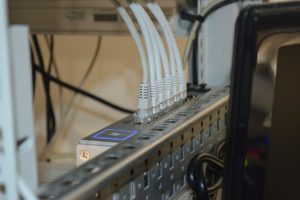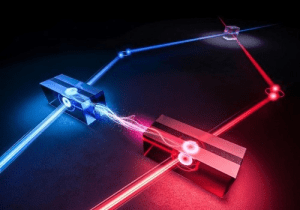Overview of the Quantum Internet A network of linked quantum computers that can send, process, and receive data in quantum states is the vision of the ground-breaking idea known as the “quantum internet.” The quantum internet, in contrast to the classical internet, will offer special features like quantum cryptography and previously unheard-of computational power, but
Overview of the Quantum Internet
A network of linked quantum computers that can send, process, and receive data in quantum states is the vision of the ground-breaking idea known as the “quantum internet.” The quantum internet, in contrast to the classical internet, will offer special features like quantum cryptography and previously unheard-of computational power, but it won’t replace our current network.
For example, bits—data represented by 0s and 1s—can be transferred across the internet today. On the other hand, qubits—which are used in the quantum internet—can exist as 0, 1, or both at the same time because of a phenomena known as superposition. The basis for solving computational issues that are outside the purview of classical systems is laid by this skill.
Quantum Computing Foundations

Photo by Thomas Jensen on Unsplash
Quantum computers, which process qubits rather than conventional bits, are the foundation of the quantum internet. Information in quantum states, such the polarization of photons or the spin of an electron, is encoded by qubits. Entanglement, in which the states of two or more qubits are related despite their distance from one another, is a fundamental characteristic of qubits.
For instance, even when separated by hundreds of miles, entangled photons created in a lab can stay connected. Secure information transfer and quantum communication are based on this phenomena.
Benefits of the Quantum Internet
The quantum internet is set to revolutionize several fields. Its benefits include:
Unbackable Communication:
Using quantum key distribution (QKD), cryptographic keys can be shared securely over quantum networks. Eavesdropping attempts disrupt the quantum states, alerting users and ensuring data integrity.
Example: In 2021, QKD was used to secure voting data during elections in Switzerland.
Enhanced Computational Power:
Quantum networks allow multiple quantum computers to work together, solving problems like protein folding for drug discovery or optimizing supply chain logistics.
Scientific Advancements:
Quantum sensors connected via the quantum internet can improve tools like gravitational wave detectors, enabling deeper exploration of phenomena such as black holes.
Applications of the Quantum Internet

Image by yandex.com
While the quantum internet is still under development, several applications are already taking shape:
Cryptography:
RSA encryption, a cornerstone of current cybersecurity, could be broken by quantum computers. The quantum internet offers a countermeasure with quantum cryptography, ensuring long-term data security.
Quantum Cloud Computing:
Instead of personal quantum computers, individuals will likely access powerful quantum systems remotely, much like cloud services today.
Example: A pharmaceutical company could use quantum cloud computing to model complex molecules for new medications.
Precision Measurements:
By linking quantum instruments, the quantum internet could enhance the precision of microscopes and telescopes.
Challenges in Building the Quantum Internet
Despite its promise, building a global quantum internet faces significant hurdles:
Signal Amplification:
Quantum signals cannot be amplified using conventional methods due to the no-clone theorem, which prohibits copying quantum states without altering them. Instead, researchers are exploring quantum repeaters to preserve data integrity across long distances.
Decoherence:
Qubits are highly sensitive to environmental disturbances, losing their quantum states when exposed to vibrations or temperature changes. Current quantum systems require near-absolute-zero conditions, though room-temperature qubits, such as defect spin qubits, show promise.
Example: Scientists at the University of Chicago have developed defect spin qubits using diamonds, maintaining quantum states for several seconds at cryogenic temperatures.
Infrastructure Limitations:
Physical connections, such as fiber-optic cables and satellites, are essential for transmitting quantum signals. While fiber optics are cheaper and widely available, satellite-based systems offer better scalability for global networks.
Regional and Global Quantum Networks
Significant strides have been made in creating quantum networks. The Chicago Quantum Exchange operates a 124-mile quantum loop connecting Argonne National Laboratory with the University of Chicago and other institutions. This network demonstrates the potential for regional quantum communication and serves as a testbed for scaling up to interstate and eventually global systems.
Future Prospects and Unknowns
The quantum internet is in its infancy, akin to the classical internet of the 1960s. As it matures, unforeseen applications will likely emerge, just as email, e-commerce, and social media transformed the classical internet. For now, its potential includes:
- Solving complex problems: From climate modeling to advanced material design.
- Global synchronization: Quantum clocks could maintain perfect time synchronization, crucial for technologies like GPS.
- Innovations in healthcare: Faster drug development and personalized treatments.
Ethical and Societal Implications

Image by Yandex.com
With immense power, comes great responsibility. The quantum internet raises ethical concerns around access and monopolization. Will the benefits be dispersed equally, or will a few groups monopolize the technology? Furthermore, while quantum cryptography improves security, quantum computers’ potential to break regular encryption raises questions about privacy and digital security.
Final Thoughts
A significant advancement in processing and communication is represented by the quantum internet. It will enable uses we cannot yet envision, such as unbreakable encryption and ground-breaking scientific discoveries, by connecting quantum computers worldwide. Even if there are still obstacles to overcome, continued research and development are making this vision a reality. History has demonstrated that revolutionary technologies frequently start out as far-fetched ideas but ultimately change the way we live and engage with the world.






















